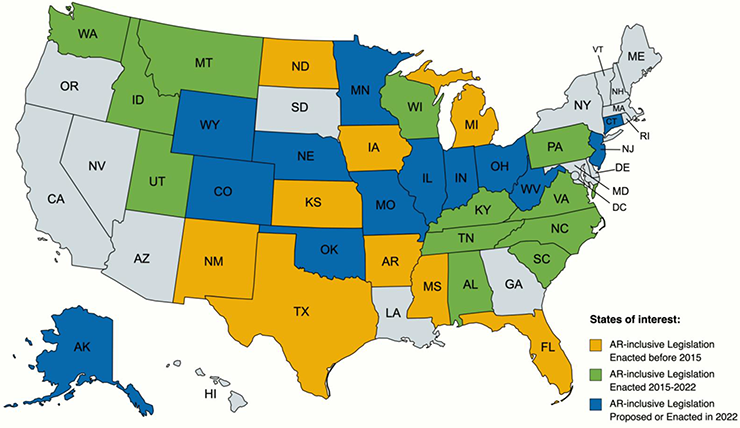An informational hearing last week on the potential for nuclear power had what might be considered the usual suspects: There was a professor of nuclear science and engineering from MIT, the director of the National Reactor Innovation Center in Idaho, a nuclear waste storage consultant from Chicago and an energy analyst from the conservative Center of the American Experiment.
But there was also someone who stood out in that mix of those speaking to the Senate Energy and Utilities Committee: an environmentalist who has been an organizer from two of the state’s most progressive organizations.

Minnesota is one of 12 states with restrictions on new nuclear power plants and has one of the most-strict moratoria. Four states have repealed restrictions in the last six years and Illinois is considering doing so this year. Though a handful of bills to lift the moratorium in Minnesota are before the state House and Senate, only one — a study of the impact of advanced nuclear technology on the state’s greenhouse gas emission reduction goals — has DFL sponsorship.
Meyer, a Falcon Heights city council member, said he grew up near Buffalo Ridge in southwest Minnesota, an area he said is sometimes called the Saudi Arabia of wind power. He supports wind and solar power but doesn’t think they will be productive enough to replace electrical generation from coal and natural gas.
“We need low-carbon electricity that isn’t dependent on the weather,” Meyer told the committee. “Our nuclear power plants have been providing that for decades, and the fact that nuclear power has the smallest environmental footprint, as an in-depth study by the UN Economic Council of Europe recently concluded, makes the case for nuclear even stronger.”
Meyer is active in a DFL that is hostile to nuclear power — the party’s platform officially opposes it — and making the case that substituting coal and natural gas power plants with nuclear power is a way to provide enough electricity to the world without producing greenhouse gasses has been difficult.
Meyer said he thinks the environmental concerns about nuclear waste are the legacy of weapons production, not commercial reactors. “All the spent nuclear fuel in the U.S. could fit on a single football field, none of it has harmed anyone, and no, it doesn’t glow green,” Meyer said.
About 20 percent of U.S. electricity is generated via nuclear power, 60 percent from coal and natural gas and 18 percent from hydro, wind and solar power.

His state senator, John Marty of Roseville, sponsored the amendment that imposed the moratorium on nuclear power, which was included in a bill that extended the authority to store spent nuclear fuel on site at Xcel Energy’s Prairie Island Nuclear Generating Plant in Red Wing. Continued use of nuclear plants is a huge part of Xcel’s plans to generate energy from carbon-free sources by 2050, with nuclear power making up roughly 27 percent of the company’s upper midwest energy supply in 2021.

Marty said he continues to have concerns about waste storage and safety, but his primary issue is the cost of building new nuclear plants — and the effect those costs would have on rate payers. The debt from a canceled nuclear facility in South Carolina is being repaid through electricity rates there, he said.
Marty, a former chair of the Senate Energy Committee, said he would consider supporting a repeal if the state also required any costs of construction of new plants to be included in rates only if a plant is completed and produces power. “I will tell those folks they may be right,” Marty said of people like Meyer. “I’m just reading and listening and hearing and seeing lots of talk and very little of real promise.”
What is grouped together as advanced nuclear technology isn’t yet viable and may never be, he said. “Supposing there’s a breakthrough tomorrow morning, when are they going to start pumping out power?” he asked.
Marty said he is aware of the argument that nuclear could replace fossil fuels in generating electricity, and said he wouldn’t have supported what Germany did to close existing plants, but he fears relying on a technology that isn’t developed will let people avoid the hard choices they need to make now to stave off climate change.
“My concern is we avoid doing real actions that could address climate because somehow we’re going to have this panacea,” Marty said. “And if in 30 years from now they find some new technology that takes care of it, that’s great. But the planet is cooked by then.”
The same committee last week heard testimony from the Nuclear Innovation Alliance about some of the new reactor and cooling technologies that are set to be built over the next decade in Washington, Idaho, Wyoming, Tennessee, Illinois and Canada, and from construction unions that support construction of new plants.

That law also charges Xcel a fee for the waste storage, which is then turned around and spent by lawmakers on renewable energy projects. The Prairie Island tribe historically hadn’t benefited from the fees, though in 2020 the Legislature approved more than $45 million for Prairie Island to implement a project aimed at helping the tribe reach net-zero carbon emissions.
The Senate Energy Committee approved three bills: a full cancellation of the moratorium so the Public Utilities Commission could consider any application for a nuclear plant; a partial lifting that would allow consideration of small-scale nuclear generation of 100 megawatts or fewer; and the bipartisan study.
Meyer recognizes environmental arguments in support of the moratorium. But he argues that doing nothing now isn’t a solution either. Other states are taking part in development of new designs that show promise — such as those being developed at the Idaho National Laboratory. But Minnesota isn’t.
And he says polling shows that Americans of both parties are more open to nuclear power now and that Democratic party officials are not adapting to the way climate change is altering perceptions.
“It can get really tribal,” Meyer said of the conversations about nuclear energy among Democrats. “It can be a way to lose social status, or at least Democrats sort of feel that it can be. But if it is just a conversation between two people and there isn’t a show for other people looking on,” conversations are more productive.
Meyer has attended the climate talks most years and said the issue was no longer taboo at the United Nations Climate Change Conference in Glasgow last year. “Seeing that evolution is pretty remarkable,” Meyer said. “I’m hoping Minnesota comes along here.”
Walker Orenstein contributed to this report.


0 Commentaires